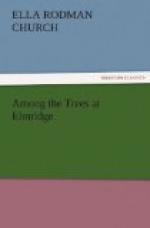“They are alike in important points, when we examine them carefully,” was the reply. “The bread-fruit genus consists, with a single exception, of trees and shrubs with alternate, toothed or lobed or entire leaves and milky juice. This reminds me that the famous cow tree of South America, which yields a large supply of rich and wholesome milk, is one of the members; and you see what a number of famous trees we have on hand now. There are several kinds of mulberries—the red, black, white and paper mulberry, which are all occasionally found in this country, and they were once quite popular here for their shade. The fruit is unusually small for tree-fruit, and very soft when ripe, as you all know; it is not unlike a long, narrow blackberry, and forms, like it, a compound fruit, as though many small berries had grown together. The tree in Mrs. Bush’s garden is the black mulberry, as any one might know by the stained lips and hands that sometimes come from there; and it has been cultivated from ancient times for its fine appearance and shade. It is found wild in the forests of Persia, and is thought to have been taken from there to Europe. The tree is more beautiful than useful, for the silkworms do not thrive well on the leaves and the wood is neither strong nor durable.”
“Why, I thought,” said Clara, “that silkworms always lived on mulberry-leaves?”
“The white mulberry is their favorite food; and another species, called the Morus multicaulis—for Morus is the scientific name of the family—has more delicate leaves than any other, and produces a finer quality of silk. These trees are natives of China, and the white mulberry grows very rapidly to the height of thirty or forty feet. The paper mulberry is so called because in China and Japan—of which it is a native—its bark is manufactured into paper. In the South-Sea Islands, where it is also found, the bark is made into the curious dresses which we sometimes see imported thence. It is a low, thick-branched tree with large light-colored downy leaves and dark-scarlet fruit.”
“I wonder,” said Malcolm, “if the bark is like birch-bark?”
“It does not look like it,” replied Miss Harson, “but it seems to be very much of the same nature. The red mulberry and black mulberry are the most hardy of these trees, and the red mulberry will thrive farther north than any of the family. The wood is valuable for many purposes for which timber is used, and especially in boat-building. And now, as we learned something about silkworms and their cocoons in our talks about insects[15], there is little more to be said of the mulberry tree which any but learned people would care to know.”
[15] See Flyers and Crawlers. Presbyterian Board of Publication.
“I want to hear about the bread tree,” said little Edith, “and how the loaves of bread grow on it.”
“Do they, Miss Harson?” asked Clara, not exactly seeing how this could be.




